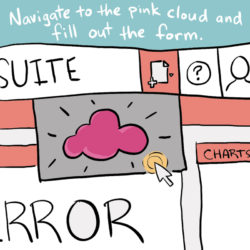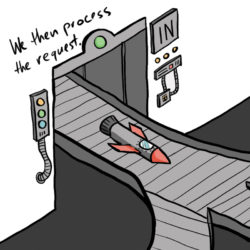In this blog post, we’ll outline a few tips that can help you improve your supply chain visibility. Stay tuned!
If you’re like most business owners, you’re always looking for ways to improve your supply chain visibility. After all, the more visibility you have into your supply chain, the easier it is to make informed decisions that can help improve your bottom line. And that’s a valuable asset for any business.
What Is Supply Chain Visibility?
Supply chain visibility is the ability to see and track every element of your supply chain from end to end. This includes all the steps involved in getting your product from supplier to customer, as well as any other relevant data points along the way.
Why Do You Need It?
Supply chain visibility is a crucial part of any business, but it can be especially important for businesses that operate in industries with long supply chains or complex products. For example, companies that manufacture and sell electronics typically have very long and complex supply chains. As a result, they need to have a high level of visibility into their supply chain to avoid disruptions that could lead to lost sales or unhappy customers.
PREVIOUS POST — NetSuite Inventory Management: A Comprehensive Guide
Technologies that enable supply chain visibility include enterprise resource planning (ERP), logistics management systems (LMS), global positioning systems (GPS), and radio frequency identification (RFID). These technologies collect data on supply chain activities, which can then be analyzed to identify trends and issues.
Indicators of Inadequate Supply Chain Visibility
Businesses are under constant pressure to improve margins and reduce costs. To do this, they need to have visibility into their supply chains. Unfortunately, many businesses lack this visibility, which can lead to problems further down the line. There are a few key indicators that businesses should be aware of. If you’re seeing any of these red flags, it’s time to take a closer look at your supply chain visibility. These include:
Long Lead Times
Long lead times can be frustrating for customers and businesses alike. When a customer orders a product, they typically expect it to arrive promptly. If the product has a long lead time, it can create unnecessary delays and frustration. In addition, long lead times can also create problems for businesses. If lead times are too long, it can cause inventory issues and production bottlenecks. As a result, businesses need to be aware of the potential dangers of long lead times and take steps to improve visibility within their supply chains.
High Levels of Inventory
High inventory levels might be an indicator of a supply chain visibility problem. If you can’t see what’s happening upstream, it’s tough to know how much inventory to keep on hand. You might have too much or too little, and both can be costly. Too much inventory ties up cash that could be used elsewhere, and too little can lead to stockouts and lost sales.
Frequent Stockouts
A stockout is defined as a situation where desired inventory or materials are not available when needed. While stockouts can occur for several reasons, they often indicate a problem with supply chain visibility. When visibility is poor, it can be difficult to track inventory levels and predict future demand. This can lead to disruptions in the supply chain and ultimately result in stockouts. In addition to stockouts, other indicators of poor supply chain visibility include unexpected delays, missing shipments, and incorrect invoices.
PREVIOUS POST — NetSuite Inventory Management: A Comprehensive Guide
Missed delivery deadlines
Missed delivery deadlines are one of the most common indicators of a visibility issue. When shipments fail to arrive on time, it can cause a ripple effect throughout the supply chain, resulting in lost revenue and frustrated customers.
Difficulty Tracking Assets
There are a few indicators that might indicate a supply chain visibility problem. One is difficulty tracking assets or product information as it passes through the supply chain. This can lead to delays in fulfilling orders, lost inventory, and frustrated customers.
Excessive Manual Data Entry
Maintaining data integrity is crucial to making good decisions based on your supply chain analytics. Unfortunately, if you or your team members are stuck manually inputting data into your system, that’s a clear sign that something isn’t quite right. Not only is manual data entry time-consuming and error-prone, but it can also introduce inaccuracies that ripple throughout your entire operation. If you find yourself having to rely on manual data entry, it’s time to take a closer look at your supply chain visibility solution. There might be a more automated way to get the data you need.
High Rates of Customer Returns
A product return generally indicates that a customer is dissatisfied with their purchase for one reason or another. If you are seeing an uptick in customer returns, it could be an indication that there is a problem with your supply chain visibility. If you are not able to track where your product is at every stage of the journey from supplier to customer, you may run into issues with quality control, fulfillment, and more.
As a result, it is essential to have a system in place that allows you to see where your products are at all times. By doing so, you can minimize the chances of a problem occurring in the first place.
So, they are some indicators of poor SCV. If you are experiencing any of these problems, it is important to take a closer look at your supply chain visibility solution.
PREVIOUS POST — Find NetSuite Body Fields with Internal ID or Label Using Chrome Extension
How Can You Improve Your Supply Chain Visibility?
Every company has a supply chain, and supply chain visibility is critical to the success of any business. A supply chain is a network of suppliers, manufacturers, distributors, and retailers that work together to get products from the point of raw materials to the end customer. The supply chain is also responsible for delivering finished goods and products back to the customer.
Many factors can impact supply chain visibility, but here are a few key tips that can help you improve visibility within your supply chain:
Define What Supply Chain Visibility Means for Your Business.
What are the specific metrics and data points that you need to track to make informed decisions? Once you have a clear understanding of what supply chain visibility means for your business, you can start to put the necessary systems and processes in place to achieve it.
Use Technology to Your Advantage.
There are many supply chain management (SCM) software solutions on the market like NetSuite that can help you track and monitor your supply chain in real time. By using SCM software, you can gain a better understanding of where your inventory is at any given time and how it’s moving through the supply chain. In addition, SCM software can also help you identify potential bottlenecks and areas of improvement within your supply chain.
Cultivate Partnerships with Suppliers and Service Providers.
Building strong relationships with your suppliers and service providers is essential for achieving supply chain visibility. When you have open lines of communication with your partners, it’s easier to resolve issues quickly and avoid potential problems down the road. In addition, working with partners that offer transparency into their operations can also help you gain insight into how they’re impacting your supply chain.
Leverage Data Analytics.
Data analytics can be a powerful tool for gaining insights into your supply chain. By analyzing data points such as supplier performance, order history, and shipping data, you can identify trends and patterns that can help improve overall supply chain visibility. Additionally, data analytics can also help you predict future demand fluctuations and plan accordingly to avoid disruptions in the supply chain.
Implement Continuous Improvement Initiatives.
Continuously strive to improve the efficiency of your supply chain by implementing Lean or Six Sigma initiatives. These process improvement methodologies can help identify areas of waste within your supply chain and implement solutions to eliminate them. As a result, you’ll be able to achieve higher levels of supply chain visibility while also improving overall performance.
So, these are some of the tips to improve Supply chain visibility. By following these tips, you can surely have better control over your Supply Chain.
RELATED POST — FAQ: 10 Things to Know About Inventory Management
What Are Some Benefits of Improving Supply Chain Visibility for Businesses?
Supply chain management is the coordination of all activities that take place along the supply chain from the acquisition of raw materials to the delivery of finished products to the end customer. In recent years, there has been a growing emphasis on supply chain visibility, which refers to the ability to track and monitor every component and activity throughout the entire supply chain. Many benefits come with improving supply chain visibility for businesses.
Increased Efficiency and Productivity
When businesses lack supply chain visibility, inefficiencies and errors are bound to happen. How can you solve a problem if you can’t see it? You need to be able to track your inventory levels, shipments, and freight costs to identify issues and optimize your operations.
With better visibility, companies can make informed decisions that lead to increased efficiency and productivity. They can avoid overstocking or running out of inventory, and they can find ways to cut costs without compromising quality.
In today’s competitive landscape, businesses need every advantage they can get. Improving supply chain visibility is one way to give your company a leg up on the competition.
Improved Customer Satisfaction
Customers are the lifeblood of any business, so it’s essential to keep them happy. One way to do this is by ensuring that they always receive their orders on time and in full. Unfortunately, disruptions to the supply chain can often lead to delays and shortages. By improving visibility into the supply chain, businesses can more easily identify potential problems and take steps to mitigate them. This, in turn, leads to improved customer satisfaction levels and a stronger reputation for reliability.
Reduced Costs
Reducing costs throughout the supply chain is one of the most prevalent benefits of increasing visibility. By having greater transparency into where your product is at every step of the journey, you can make better decisions about how to get it from point A to point B.
This includes everything from choosing the most efficient shipping routes to stocking the right levels of inventory. In many cases, even a small reduction in costs can have a significant impact on the bottom line. As such, improved supply chain visibility is a key driver for businesses looking to reduce their overall expenses.
Reduced Inventory Costs
Improving supply chain visibility can help businesses to better manage their inventory levels and reduce costs. By gaining a more accurate picture of where inventory is located at all times, businesses can avoid the cost of overstocking or the lost sales associated with stockouts.
In addition, real-time visibility into the supply chain can help businesses to identify bottlenecks and other potential problems that may impact inventory levels. As a result, improving supply chain visibility can lead to reduced inventory costs and a more efficient operation overall.
Faster Response to Market Changes
We all know that the business world is constantly changing and evolving. What was new and innovative yesterday could be outdated and replaced by something better tomorrow. To stay ahead of the competition, businesses need to be able to rapidly adapt to changes in the market.
However, this can be difficult if there is a lack of visibility into the supply chain. By improving supply chain visibility, businesses can more quickly identify and respond to changes in market conditions. As a result, they can stay ahead of the competition and maintain a competitive advantage.
In addition, improved supply chain visibility can also lead to reduced costs and improved efficiencies. When businesses have visibility into their supply chains, they can identify areas where improvements can be made. As a result, they can implement changes that lead to reduced costs and improved efficiencies.
More Accurate Forecasting
Forecasting is a critical part of supply chain management, as it allows businesses to anticipate future demand and plan accordingly. The accuracy of forecasting can have a major impact on a company’s bottom line, as it can lead to either excess inventory or stockouts. By improving visibility throughout the supply chain, businesses can collect more accurate data that can be used to improve forecasting accuracy.
These are the benefits that Supply Chain Visibility (SCV) can bring to your business.
Common Challenges to Improved Supply Chain Visibility
In today’s business landscape, the ability to effectively track and manage inventory has never been more important. Thanks to the rise of eCommerce and the growth of global supply chains, businesses now have to contend with some challenges that can make it difficult to maintain accurate visibility into their inventory levels.
We’ll take a look at five of the most common challenges faced by businesses when trying to improve supply chain visibility.
Lack of Data Integration
One of the biggest challenges faced by businesses when trying to improve SCV is a lack of data integration. For a business to have an accurate picture of its inventory levels, they need to be able to consolidate data from various sources—including but not limited to logistics providers, suppliers, and customers—into a single system.
This can be a difficult task for businesses that don’t have robust data management systems in place. Without proper data integration, businesses will struggle to get an accurate picture of their inventory levels and may end up making decisions based on outdated or incomplete information.
Inaccurate Data
Another common challenge faced by businesses when trying to improve SCV is inaccurate data. This is often due to a lack of standardization across different data sources. For example, one supplier might use a different product ID than another supplier, making it difficult for the receiving business to accurately track inventory levels.
Inaccurate data can also be caused by human error, such as when an employee manually enters incorrect data into the system or fails to update information on time. This can lead to delays in shipments and other disruptions further down the supply chain.
Lack of Automation
Another common challenge faced by businesses when trying to improve supply chain visibility is a lack of automation. Many businesses still rely on manual processes—such as paper-based documentation—to track their inventory levels, which can lead to errors and delays.
In addition, manual processes make it difficult for businesses to scale their operations as they grow. As more orders come in, it becomes increasingly difficult for businesses to keep up with the demand if they’re relying on manual processes. This can lead to disruptions in the supply chain and frustrated customers who are waiting for their orders.
Lack of Real-Time Visibility
This is often because many existing systems only provide Updates on a daily or weekly basis—if at all—which can make it difficult for businesses to make timely decisions about their operations.
Poor Forecasting
Many businesses don’t invest enough time in planning for future demand, which can lead to disruptions in the supply chain when orders exceed the available inventory. This can be annoying for customers who are waiting for their orders and damaging to the business’s reputation.
Improving supply chain is essential for modern businesses but it comes with its own set of challenges. By understanding the most common issues businesses face when trying to improve their visibility, you can take steps to overcome them and keep your business running smoothly.
RELATED POST — How to Automate the “First Expired, First Out” Inventory Method Using NetSuite ERP
Why Choose NetSuite as Your Supply Chain Management System (SCMS)?
There are many compelling reasons to choose NetSuite as your supply chain management system. NetSuite provides real-time visibility into every aspect of your supply chain, from raw materials to finished products. This visibility enables you to make better decisions about production schedules, inventory levels, and procurement strategies.
In addition, NetSuite’s sophisticated planning and forecasting capabilities help you to anticipate changes in demand and adjust your supply chain accordingly. And because NetSuite is a cloud-based solution, it is easy to implement and scale as your business grows. When it comes to managing your supply chain, NetSuite is a clear choice.
Final Thoughts
As the global economy has become more interconnected, businesses of all sizes have had to increasingly rely on complex supply chains. To be successful, businesses need to have visibility into their supply chains. Unfortunately, achieving visibility is often easier said than done.
Some common challenges can make it difficult to improve supply chain visibility, including data silos, manual processes, and lack of transparency. However, by taking steps to overcome these challenges, businesses can ensure that their supply chains are running smoothly. And when it comes to choosing a supply chain management system, NetSuite is a clear choice.
Contact us today to learn more about how NetSuite can help your business.










